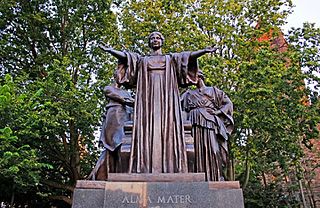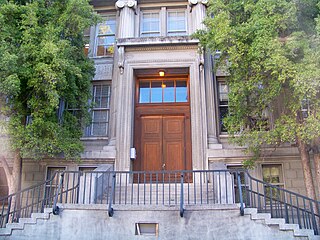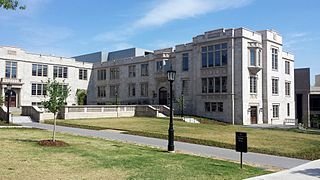
The University of Saskatchewan is a Canadian public research university, founded on March 19, 1907, and located on the east side of the South Saskatchewan River in Saskatoon, Saskatchewan, Canada. An "Act to establish and incorporate a University for the Province of Saskatchewan" was passed by the provincial legislature in 1907. It established the provincial university on March 19, 1907 "for the purpose of providing facilities for higher education in all its branches and enabling all persons without regard to race, creed or religion to take the fullest advantage". The University of Saskatchewan is the largest education institution in the Canadian province of Saskatchewan. The University of Saskatchewan is one of Canada's top research universities and is a member of the U15 Group of Canadian Research Universities.

The University of Arkansas is a public land-grant research university in Fayetteville, Arkansas. It is the flagship campus of the University of Arkansas System and the largest university in Arkansas. Founded as Arkansas Industrial University in 1871, classes were first held on January 22, 1872, with its present name adopted in 1899. It is noted for its strong programs in architecture, agriculture, communication disorders, creative writing, history, law, and Middle Eastern studies, as well as for its business school, of which the supply chain management program was ranked the best in North America by Gartner in July 2020. In a 2021 study compiled by DegreeChoices and published by Forbes, the University of Arkansas ranked 13th among universities with the most graduates working at top Fortune 500 companies.

Pratt Institute is a private university with its main campus in Brooklyn, New York. It has a satellite campus in Manhattan and an extension campus in Utica, New York at the Munson-Williams-Proctor Arts Institute. The school originated in 1887 with programs primarily in engineering, architecture, and fine arts. Comprising six schools, the institute is primarily known for its programs in architecture, interior design, and industrial design.

The Main Quadrangle at the University of Illinois Urbana-Champaign comprises the main campus of the university. It is a major quadrangle surrounded by buildings of the College of Liberal Arts and Sciences (LAS) and is the center of campus activities.

Gilman Hall is a building on the campus of the University of California, Berkeley. Room 307 was where Glenn T. Seaborg and his coworkers identified plutonium as a new element on February 23, 1941 and as such, is designated a National Historic Landmark. The building itself is designated a National Historic Chemical Landmark, recognizing the two Nobel Prizes in Chemistry that have resulted from research done in the building.

Thackeray Hall is an academic building of the University of Pittsburgh and a contributing property to the Schenley Farms National Historic District at 139 University Place on the campus of the University of Pittsburgh in Pittsburgh, Pennsylvania, United States.

George Hubbard Clapp Hall is a contributing property to the Schenley Farms National Historic District on the campus of the University of Pittsburgh in the Oakland section of Pittsburgh, Pennsylvania. The six-story Gothic Revival structure, designed by Trautwein & Howard, was completed in 1956 and serves as the primary facility of the University of Pittsburgh Department of Biological Sciences. It contains laboratories, classrooms, a greenhouse, and an amphitheater-style lecture hall with 404 seats.

John Clinton Futrall was an American football coach and college administrator. An alumnus of the Arkansas Industrial University, later renamed the University of Arkansas, he was the first head coach of the Arkansas Razorbacks football program, serving from 1894 to 1896, while the school's mascot was still the Cardinal. Futrall later served as president of the University of Arkansas from 1913 to 1939. He was killed in an auto accident in 1939. The first student union on the University of Arkansas campus was named Futrall Memorial Hall in his honor when it opened later that year.
This is an incomplete list of historic properties and districts at United States colleges and universities that are listed on the National Register of Historic Places (NRHP). This includes National Historic Landmarks (NHLs) and other National Register of Historic Places listings. It includes listings at current and former educational institutions.

The Enrollment Services Center is a building at Iowa State University in Ames, Iowa. It houses Offices in Enrollment Services: Admissions, Orientation, Records and registration. In 1978, the building was placed on the National Register of Historic places.

The History of the University of Arkansas began with its establishment in Fayetteville, Arkansas, in 1871 under the Morrill Act, as the Arkansas Industrial College. Over the period of its nearly 140-year history, the school has grown from two small buildings on a hilltop to a university with diverse colleges and prominent graduate programs. Its presidents have included Civil War general Daniel Harvey Hill, John C. Futrall, and J. William Fulbright.

The Jim & Joyce Faulkner Performing Arts Center is a performing arts center on the University of Arkansas campus in Fayetteville, Arkansas.

The Chemistry Building at the University of Arkansas is a building on the University's campus in Fayetteville, Arkansas. The building was added to the National Register of Historic Places in 1992.

The Agriculture Building at the University of Arkansas is a building on the University's campus in Fayetteville, Arkansas. The building was added to the National Register of Historic Places in 1992.

Gearhart Hall at the University of Arkansas is a building on the University's campus in Fayetteville, Arkansas. The building was added to the National Register of Historic Places in 1992.
The Campus of Clemson University was originally the site of U.S. Vice President John C. Calhoun's plantation, named Fort Hill. The plantation passed to his daughter, Anna, and son-in-law, Thomas Green Clemson. On Clemson's death in 1888, he willed the land to the state of South Carolina for the creation of a public university.

The History of Louisiana Tech University began when the Industrial Institute and College of Louisiana was founded in Ruston, Louisiana in 1894. The institute was founded to develop an industrial economy in the state of Louisiana. Four years later, the school was renamed the Louisiana Industrial Institute when Louisiana adopted the Constitution of 1898. When the Constitution of 1921 was passed, the school changed its name again to Louisiana Polytechnic Institute to reflect the school's evolution from a trade school into a larger and broader technical institute. Although the university was informally called Louisiana Tech for about five decades after the 1921 name change, it was not until 1970 when Louisiana Polytechnic Institute officially changed its name to Louisiana Tech University. Over the course of its history, the school grew from a small industrial institute with one building to a university with five colleges and an enrollment of around 11,800 students.

Peabody Hall is a building on the University of Arkansas campus in Fayetteville, Arkansas. The 1913 structure is a contributing property to the University of Arkansas Campus Historic District, which is listed on the National Register of Historic Places. Peabody Hall has continuously housed the teacher education department since completion in 1913. Today, the department is part of the University of Arkansas College of Education and Health Professions. It was built using private funds from George Peabody, one of the fathers of modern philanthropy.

The Agricultural and Technical College of North Carolina Historic District is 10.1-acre (41,000 m2) historic district along the western boundary of the campus of North Carolina Agricultural and Technical State University in Greensboro, North Carolina. The area includes five historical Colonial Revival, Classical Revival style buildings. Some significant structures are among those located within the Historic District include the James B. Dudley Memorial Building and Harrison Auditorium. The district has been listed on the National Register of Historic Places since October 20, 1988.

The Hector F. DeLuca Biochemistry Building, originally known as the Agricultural Chemistry Building, is a historic structure on the campus of the University of Wisconsin–Madison. It was the site of the discovery of vitamins A and B, as well as the development of vitamin D processing.



































